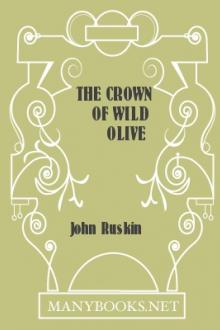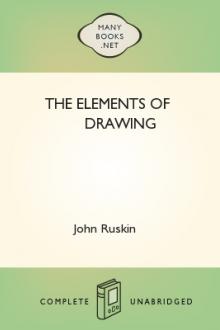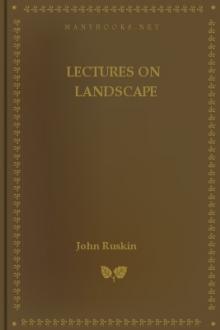The Crown of Wild Olive by John Ruskin (a court of thorns and roses ebook free .TXT) 📕

- Author: John Ruskin
- Performer: -
Book online «The Crown of Wild Olive by John Ruskin (a court of thorns and roses ebook free .TXT) 📕». Author John Ruskin
But, as matter of historical fact, the idea of such presence has generally been both ignoble and false, and confined to nations of inferior race, who are often condemned to remain for ages in conditions of vile terror, destitute of thought. Nearly all Indian architecture and Chinese design arise out of such a state: so also, though in a less gross degree, Ninevite and Phœnician art, early Irish, and Scandinavian; the latter, however, with vital elements of high intellect mingled in it from the first.
But the greatest races are never grossly subject to such terror, even in their childhood, and the course of their minds is broadly divisible into three distinct stages.
47. (I.) In their infancy they begin to imitate the real animals about them, as my little girl made the cats and mice, but with an undercurrent of partial superstition—a sense that there must be more in the creatures than they can see; also they catch up vividly any of the fancies of the baser nations round them, and repeat these more or less apishly, yet rapidly naturalizing and beautifying them. They then connect all kinds of shapes together, compounding meanings out of the old chimeras, and inventing new ones with the speed of a running wild-fire; but always getting more of man into their images, and admitting less of monster or brute; their own characters, meanwhile, expanding and purging themselves, and shaking off the feverish fancy, as springing flowers shake the earth off their stalks.
48. (II.) In the second stage, being now themselves perfect men and women, they reach the conception of true and great gods as existent in the universe; and absolutely cease to think of them as in any wise present in statues or images; but they have now learned to make these statues beautifully human, and to surround them with attributes that may concentrate their thoughts of the gods. This is, in Greece, accurately the Pindaric time, just a little preceding the Phidian; the Phidian is already dimmed with a faint shadow of infidelity; still, the Olympic Zeus may be taken as a sufficiently central type of a statue which was no more supposed to be Zeus, than the gold or elephants' tusks it was made of; but in which the most splendid powers of human art were exhausted in representing a believed and honoured God to the happy and holy imagination of a sincerely religious people.
49. (III.) The third stage of national existence follows, in which, the imagination having now done its utmost, and being partly restrained by the sanctities of tradition, which permit no farther change in the conceptions previously created, begins to be superseded by logical deduction and scientific investigation. At the same moment, the elder artists having done all that is possible in realizing the national conceptions of the Gods, the younger ones, forbidden to change the scheme of existing representations, and incapable of doing anything better in that kind, betake themselves to refine and decorate the old ideas with more attractive skill. Their aims are thus more and more limited to manual dexterity, and their fancy paralyzed. Also, in the course of centuries, the methods of every art continually improving, and being made subjects of popular inquiry, praise is now to be got, for eminence in these, from the whole mob of the nation; whereas intellectual design can never be discerned but by the few. So that in this third æra, we find every kind of imitative and vulgar dexterity more and more cultivated; while design and imagination are every day less cared for, and less possible.
50. Meanwhile, as I have just said, the leading minds in literature and science become continually more logical and investigative; and, once that they are established in the habit of testing facts accurately, a very few years are enough to convince all the strongest thinkers that the old imaginative religion is untenable, and cannot any longer be honestly taught in its fixed traditional form, except by ignorant persons. And at this point the fate of the people absolutely depends on the degree of moral strength into which their hearts have been already trained. If it be a strong, industrious, chaste, and honest race, the taking its old gods, or at least the old forms of them, away from it, will indeed make it deeply sorrowful and amazed; but will in no whit shake its will, nor alter its practice. Exceptional persons, naturally disposed to become drunkards, harlots, and cheats, but who had been previously restrained from indulging these dispositions by their fear of God, will, of course, break out into open vice, when that fear is removed. But the heads of the families of the people, instructed in the pure habits and perfect delights of an honest life, and to whom the thought of a Father in heaven had been a comfort, not a restraint, will assuredly not seek relief from the discomfort of their orphanage by becoming uncharitable and vile. Also the high leaders of their thought gather their whole strength together in the gloom; and at the first entrance of this valley of the Shadow of Death, look their new enemy full in the eyeless face of him, and subdue him, and his terror, under their feet. "Metus omnes, et inexorabile fatum,... strepitumque Acherontis avari." This is the condition of national soul expressed by the art, and the words, of Holbein, Durer, Shakspeare, Pope, and Goethe.
51. But if the people, at the moment when the trial of darkness approaches, be not confirmed in moral character, but are only maintaining a superficial virtue by the aid of a spectral religion; the moment the staff of their faith is broken, the character of the race falls like a climbing plant cut from its hold: then all the earthliest vices attack it as it lies in the dust; every form of sensual and insane sin is developed, and half a century is sometimes enough to close, in hopeless shame, the career of the nation in literature, art, and war.
52. Notably, within the last hundred years, all religion has perished from the practically active national mind of France and England. No statesman in the senate of either country would dare to use a sentence out of their acceptedly divine Revelation, as having now a literal authority over them for their guidance, or even a suggestive wisdom for their contemplation. England, especially, has cast her Bible full in the face of her former God; and proclaimed, with open challenge to Him, her resolved worship of His declared enemy, Mammon. All the arts, therefore, founded on religion, and sculpture chiefly, are here in England effete and corrupt, to a degree which arts never were hitherto in the history of mankind: and it is possible to show you the condition of sculpture living, and sculpture dead, in accurate opposition, by simply comparing the nascent Pisan school in Italy with the existing school in England.
53. You were perhaps surprised at my placing in your educational series, as a type of original Italian sculpture, the pulpit by Niccola Pisano in the Duomo of Siena. I would rather, had it been possible, have given the pulpit by Giovanni Pisano in the Duomo of Pisa; but that pulpit is dispersed in fragments through the upper galleries of the Duomo, and the cloister of the Campo Santo; and the casts of its fragments now put together at Kensington are too coarse to be of use to you. You may partly judge, however, of the method of their execution by the eagle's head, which I have sketched from the marble in the Campo Santo (Edu., No. 113), and the lioness with her cubs, (Edu., No. 103, more carefully studied at Siena); and I will get you other illustrations in due time. Meanwhile, I want you to compare the main purpose of the Cathedral of Pisa, and its associated Bell Tower, Baptistery, and Holy Field, with the main purpose of the principal building lately raised for the people of London. In these days, we indeed desire no cathedrals; but we have constructed an enormous and costly edifice, which, in claiming educational influence over the whole London populace, and middle class, is verily the Metropolitan cathedral of this century,—the Crystal Palace.
54. It was proclaimed, at its erection, an example of a newly discovered style of architecture, greater than any hitherto known,—our best popular writers, in their enthusiasm, describing it as an edifice of Fairyland. You are nevertheless to observe that this novel production of fairy enchantment is destitute of every kind of sculpture, except the bosses produced by the heads of nails and rivets; while the Duomo of Pisa, in the wreathen work of its doors, in the foliage of its capitals, inlaid colour designs of its façade, embossed panels of its baptistery font, and figure sculpture of its two pulpits, contained the germ of a school of sculpture which was to maintain, through a subsequent period of four hundred years, the greatest power yet reached by the arts of the world in description of Form, and expression of Thought.
55. Now it is easy to show you the essential cause of the vast discrepancy in the character of these two buildings.
In the vault of the apse of the Duomo of Pisa, was a colossal image of Christ, in coloured mosaic, bearing to the temple, as nearly as possible, the relation which the statue of Athena bore to the Parthenon; and in the same manner, concentrating the imagination of the Pisan on the attributes of the God in whom he believed.
In precisely the same position with respect to the nave of the building, but of larger size, as proportioned to the three or four times greater scale of the whole, a colossal piece of sculpture was placed by English designers, at the extremity of the Crystal Palace, in preparation for their solemnities in honour of the birthday of Christ, in December, 1867 or 1868.
That piece of sculpture was the face of the clown in a pantomime, some twelve feet high from brow to chin, which face, being moved by the mechanism which is our pride, every half minute opened its mouth from ear to ear, showed its teeth, and revolved its eyes, the force of these periodical seasons of expression being increased and explained by the illuminated inscription underneath "Here we are again."
56. When it is assumed, and with too good reason, that the mind of the English populace is to be addressed, in the principal Sacred Festival of its year, by sculpture such as this, I need scarcely point out to you that the hope is absolutely futile of advancing their intelligence by collecting within this building, (itself devoid absolutely of every kind of art, and so vilely constructed that those who traverse it are continually in danger of falling over the cross-bars that bind it together) examples of sculpture filched indiscriminately from the past work, bad and good, of Turks, Greeks, Romans, Moors, and Christians, miscoloured, misplaced, and misinterpreted;[117] here thrust into unseemly corners, and there mortised together into mere confusion of heterogeneous obstacle; pronouncing itself hourly more intolerable in weariness, until any kind of relief is sought from it in steam wheelbarrows or cheap toy-shops; and most of all in beer and meat, the corks and the bones being dropped through the chinks in the damp deal flooring of the English Fairy Palace.
57. But you will probably think me unjust in assuming that a building prepared only for the amusement of the people can typically represent the architecture or sculpture of modern England. You may urge, that I ought rather to describe the qualities of the refined sculpture which is executed in large





Comments (0)